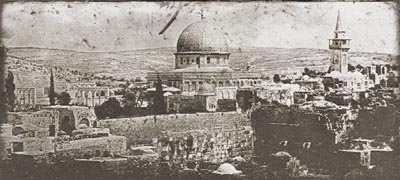| The
History
of Israel
- A Chronological Presentation

1.
Early Times (313 - 1917)
313
- The Byzantine Era
The Roman Emperor Constantine decreed that
Christianity would henceforth be the official religion
of the Roman Empire, and in 331 AD he moved its capital
from Rome to Byzantium, which he then renamed Constantinople
(today Istanbul in Turkey). At the end of the century
Judea too, now known as Palestine, was a mainly Christian
area. Churches and monasteries were being built in
the holy places in Jerusalem, Bethlehem and Galilee,
and Jews again were denied access to Jerusalem.
614 - The Persians Return
The Persians (from today's Iran) briefly
gained control over Jerusalem. But when the Byzantine
emperor, Heraclius, repulsed the Persian invasion,
and in 629 reconquered the city, he ordered all Jews
killed and all synagogues burned. Many Jews sought
refuge in Egypt or other parts of the empire.
637 - Arab Rule
In the 630's a new religion, Islam, began
spreading from the Arabian peninsula, and within only
a few years both the Persian and Byzantine empires
were defeated. In 638 Jerusalem fell to the Arab caliph
Omar and became part of the Muslim empire, which was
ruled from the caliphate in the city of Medina (in
today's Saudi-Arabia). Omar founded the first mosque
at the site in Jerusalem, where the Jewish temple
had previously been located.
The following centuries were caracterized by internal
strife in the Muslim world. Changing caliphs ruled over
most of the Middle East from Damascus (from 661) and
Baghdad (from 750). Jews and Christians were tolerated,
but subject to special restrictions, which led many
to either emigrate or convert to Islam. In 969 Jerusalem
was conquered by the Fatimid dynasty, the rivaling caliphate
in Cairo, and in 1071 the Arab dominance ended, when
the Fatimids were ejected by the Seljuk Turks.

Jerusalem
(painted by David Roberts, 1842).
1099 - The Crusaders
Pope Urban II called for a crusade against
the Muslims in order to reclaim the Holy Land for the
Christians, and in 1099 the first crusaders conquered
Jerusalem, while massacring a large number of Jews and
Muslims. During the following two centuries the European
crusaders fought various Muslim rulers for control of
the area. In 1187 Saladin, a Kurdish general who ruled
over both Egypt and Syria, succeeded in recapturing
Jerusalem for the Muslims.
1291 - The Mamelukes
In 1250 the Mamelukes (originally an army of slaves
mainly from Turkey and northern Caucasia) seized power
in Egypt from Saladin's Ayyubid dynasty. The Crusaders'
last bastion in the Holy Land, the port city of Acre,
fell to the Mamelukes in 1291. In the next 200 years,
with Palestine being ruled from Damascus, the province
ceased to function as a centre for trade from the
Far East, and the population, including the few thousand
Jewish families that were left, lived in extreme poverty.
Several towns lay in ruins, and even Jerusalem was
almost deserted. In 1351 Palestine was struck by the
plague, and around 1500 the area's population numbered
a mere 200.000 souls. The Mamelukes ruled the area
from Egypt to Syria until they were defeated by the
Ottoman Turks.
1517-1917 - The
Ottoman Empire
In 1517 Kairo fell to the Ottoman Turks,
who then ruled the entire Middle East from Constantinople
(now Istanbul) for the next 400 years. The area known
as Judea or Palestine was no longer considered a political
entity of its own, but became part of the Ottoman
Empire's Syrian province with Damascus as its local
administrative capital. The region remained neglected
and underdeveloped, and largely isolated from the
outside world.

One
of the earliest photos of Jerusalem, 1844.
Continue:
Chapter 2 - The Establishment of Israel
Back
|